Abstract
This study focuses on the investigation of the Tepehan landslide triggered by the 6 February 2023, Kahramanmaraş earthquake in Türkiye. The overall goal of this study is to understand the slope condition and simulate the failure considering pre- and post-event geometry. Topographic variations in the landslide area were analyzed using digital elevation models (DEMs) derived from the Sentinel-1 Synthetic Aperture Radar (SAR) satellite data and geospatial analysis. Slope stability analyses were conducted over a representative alignment, including assessments of soil structure, geological history, and field features. A limit equilibrium back-analysis was performed under both static and pseudo-static conditions, where an earthquake load coefficient was considered in the analyses. A total of five scenarios were evaluated to determine factors of safety (FoS) based on fully softened and residual strength parameters. The resulting critical slip surfaces from the simulations were compared with the geomorphometric analysis, necessitating the adjustment of the subsurface hard clay layer for residual conditions. The analyses revealed that the slope behaves as a delayed first-time landslide, with bedding planes acting as localized weak layers, reducing mobilized shear strength. This integrated remote sensing–geotechnical approach advances landslide hazard evaluation by enhancing the precision of slip surface identification and post-seismic slope behavior modeling, offering a valuable framework for similar post-disaster geohazard assessments.
1. Introduction
On 6 February 2023, two significant earthquakes struck Türkiye. The first earthquake occurred at 4:17 am (GMT +3) in Pazarcık, Kahramanmaraş, with a magnitude of 7.7 along the NE–SW trending Eastern Anatolian Fault Zone (EAFZ), and the second one at 1:24 pm (GMT +3) in Ekinözü, Kahramanmaraş, with a magnitude of 7.6 along the E–W trending Çardak Fault (ÇF). These earthquakes, occurring about nine hours apart, affected 11 provinces over a 400 km area from their epicenters, resulting in over 50,000 deaths and the destruction or severe damage of more than 100,000 buildings [1]. The rupture length for the first earthquake reached approximately 350 km, while the second reached about 160 km. Field observations and reports indicated that the first earthquake had a more significant impact in Kahramanmaraş and Hatay. The initial quake, with a focal depth of 8.6 km, triggered the EAFZ and caused widespread damage, including a maximum Mercalli intensity of XII (extreme) in Antakya, Hatay Province’s capital. The epicenters of the two earthquakes were 95 km apart [1,2]. In addition to the damages in the infrastructure, the earthquake triggered more than 3600 landslides, according to initial assessments [3]. Immediately after the event, NASA identified more than 1000 large slope deformations and movements from the satellite images. Among these landslides, a large failure in an olive grove in Hatay Province near Tepehan village was documented. The Tepehan landslide as shown in Figure 1, classified as a translational (block slide) failure, likely occurred on a weak layer in a dip slope. This major landslide involved substantial ground movement, splitting the field approximately 300 m wide, 500 m long, and 30 m deep [4].
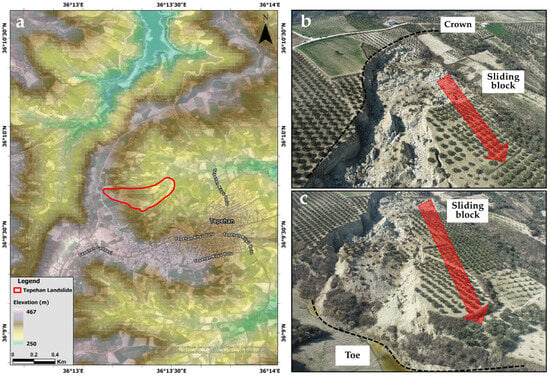
Figure 1.
(a) Topography of the study area (overlaid with the optical image); aerial pictures of the landslide: (b) view from crown; (c) view from toe.
A geotechnical reconnaissance team was deployed in the study area using Unmanned Aerial Vehicles (UAV) to collect three-dimensional footage of the Tepehan landslide and aerial views were obtained as shown in Figure 1. The region is mainly composed of Neogene-aged sandstone, clayey limestone, shale, and marl. These rock types generally have loose structures and cracks, resulting in a low coefficient of friction and limited strength. As slope steepness increases, these rocks become prone to sliding and falling when interacting with factors such as rainfall, groundwater movement, earthquakes, erosion, and human activities [5,6]. The slope angle of the landslide ranges from 15 to 25 degrees and it steepens towards the toe. Initial observations and witness statements indicate that several dry seasons, which might have caused desiccation cracks, were inundated and saturated by heavy rainfall preceding the earthquakes [7].
Initial assessment and findings raised several research questions and highlighted the necessity of an in-depth investigation. Processed digital elevation models (DEM) revealed previous movements in the area. Therefore, in this study, the past, shortly before, and after the earthquake event conditions of the slope were assessed. The efforts include a topographic definition of the area using DEM data obtained from the Sentinel-1 and PALSAR-2 satellites. Based on field observations of the geological characteristics, existing knowledge in the literature, and the available data, slope stability back-analyses were performed by evaluating the topographical behavior and computing the Factor of Safety (FoS) for the site conditions using a pseudo-static approach. A series of scenarios, considering engineering properties and history of the failure plane, were analyzed to understand the occurrence conditions of the slope failure and the parameters affecting site performance. While the combined effect of soil saturation and earthquake forces could be significant from a multi-risk analysis perspective, this factor was not addressed in the current study. Nonetheless, it is recognized as an important consideration for future research on soil behavior.
2. Background
2.1. Site Description
The geology of the area consists of the Tepehan Formation, named after the village, located in the study area as shown in Figure 2. The Tepehan Formation originated in the Cenozoic era, specifically from the middle Miocene to the early Pliocene epochs. During this period, marls and sandstones were deposited, with the base consisting of well-sorted, cross-bedded sands and some conglomeratic layers. The easily erodible nature of the underlying rocks results in a flat or gently undulating basal topography in these areas [8].
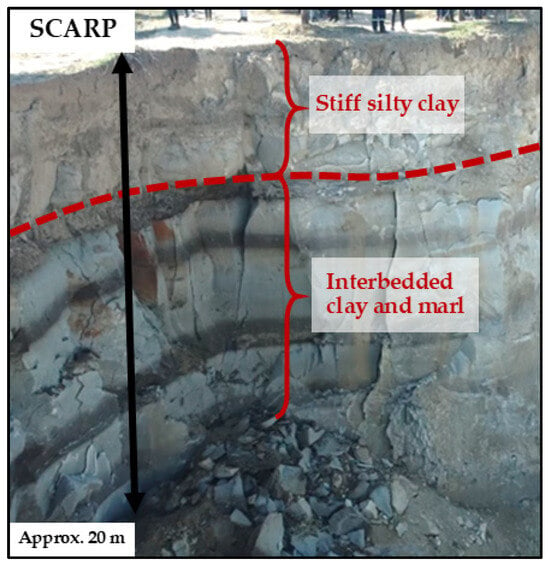
Figure 2.
Stratigraphy exposed on the scarp face of the landslide.
Ref. [9] described the characteristics of these strata, where the weathered surface of the sandstones is light gray to gray, while the freshly fractured surface is yellowish beige. The sandstones are medium to thickly layered and generally loosely cemented, containing fossils. These cavities are very thin and break easily. The weathered surface of the clayey limestones is yellowish gray, with a fresh fracture surface that is light yellow-beige. They exhibit significant stratification, with thin to medium-thick layers. The claystone is light gray-greenish and displays thin layering and lamination, with yellowish and reddish sandstones appearing as lenses within the claystone. The weathered surface of the marls is greenish gray, with patches of yellowish-white, while the freshly broken surface is gray.
The stratigraphy exposed on the scarp face of the landslide consists of an upper 4 m thick layer that easily disintegrates with water, as described by [2], overlaying a clay-rich limestone unit interbedded with marl [3]. This stratigraphy is comparable with that investigated at working station TK 3136 (AI_029_MAT02) in Altınözü, Hatay, by the National Strong-Motion Seismograph Network in Türkiye [10], located south of the study area within the Tepehan Formation. At this location, the soil profile identified stiff silty clay up to the upper five meters, transitioning to clay and weak claystone up to twelve meters, followed by weak claystone. The layer descriptions provided in Table 1 for this study are based on the defined geology of the site and the additional mentioned site investigation.

Table 1.
Stratigraphy defined for the analysis.
One important parameter for analysis is the location of the slip surface observed in the site, which has been identified as a deep, weak, thin layer within the interbedded strata [6]. According to the studies performed in the area, the sliding surface is estimated to occur at a depth of 20 to 30 m parallel to the ground surface [2,3]. Therefore, the location of the sliding surface has been estimated to be at 25 m, where it is assumed to coincide with the contact between the interbedded clay and marl, and the hard clay to weak claystone layers.
2.2. Earthquake Parameters
The earthquake data are derived from the nearest strong-motion record compiled by the Earthquake Department of the General Directorate of Disaster Affairs of Türkiye (AFAD). Station TK 3136 (36.1159 N, 36.2472 S), situated at an elevation of 269 m, is the closest to the landslide, located 5.4 km to the south in Altınözü, Hatay. Furthermore, this station is situated within the same geological formation as the study site.
At this station, the earthquake in Pazarcık (Kahramanmaraş) was recorded with a magnitude of 7.7 Mw at a depth of 8.6 km. The recorded Peak Ground Acceleration (PGA) was 402.0 cm/s2, with a Peak Ground Velocity (PGV) of 54.23 cm/s and a Peak Ground Displacement (PGD) of 48.25 cm in the E–W component. In the N–S component, the PGA was 534.2 cm/s2, with a PGV of 52.05 cm/s and a PGD of 34.99 cm. And, in the U–D component, the PGA was 220 cm/s2, with a PGV of 29.46 cm/s and a PGD of 20.03 cm. The maximum significant duration of shaking was 32.97 s. The time series of recorded acceleration in each direction is shown in Figure 3a–c.

Figure 3.
Recorded Peak Ground Accelerations (PGA) at TK 3136 AFAD Station: (a) East–West component, (b) North–South component, (c) Up–Down component.
To define the constant horizontal force that will simulate the effects of the earthquake within the pseudo-static approach, it is necessary to make a compatible selection of the horizontal seismic coefficient (kh). However, the force acts in one direction for only a few tenths of a second before reversing direction. As a result, these transient forces will produce a series of displacement pulses rather than causing slope failure. Satisfactory performance is determined by whether the accumulated displacement remains within tolerable limits. It is acceptable to select a seismic coefficient that is a fraction of the maximum seismic demand, as exceeding the maximum seismic resistance occasionally will only lead to minor accumulated seismic displacement [11].
Various researchers have proposed horizontal seismic coefficients (kh) for different earthquake intensities and conditions. Terzaghi, cited by [12], suggested kh values ranging from 0.1 for severe to 0.5 for catastrophic earthquakes. Ref. [13] recommended kh = 0.1 for magnitude 6.5 and kh = 0.15 for 8.25, with a factor of safety (FoS) > 1.15 to control embankment displacements. Refs. [14,15] advised using one-third to one-half of the peak horizontal ground acceleration (PHGA), showing that this can limit permanent displacements. Ref. [16] reported kh values of 0.05–0.15 in the U.S. and 0.12–0.25 in Japan. Ref. [17] considered displacements acceptable when kh was set to one-third to one-fifth of the PHGA, provided that the FoS remained above 1.0.
In this case study, a PHGA value of 0.68 g was determined from the highest recorded accelerations in the E–W and N–S directions during the earthquake. Considering the recommendations of [14,15,17], applying one-quarter to one-half of this value (0.17–0.34 g) is reasonable. Therefore, a mean value of 0.25 g is adopted for the analysis, as it aligns with these guidelines.
3. Methods
3.1. Geomorphometric Analysis
A geomorphometric analysis involves the quantitative analysis of land surfaces, focusing on the refinement and processing of elevation data, the description and visualization of topography, and a wide variety of numerical analyses [18]. The application process consists of extracting parameters and objects from DEMs, which are essential inputs for morphometric analysis.
Geomorphometry analysis is typically performed in five steps: (1) sampling the land surface for height measurements, (2) generating a surface model from these measurements, (3) error correction of the model, (4) derivation of land-surface parameters and objects, and (5) application of the data [19].
3.2. InSAR DEM
To conduct the geomorphometric analysis of the area, DEMs before and after the earthquake are needed. Since no DEM is available after the earthquake, the C-band Sentinel-1 and L-band ALOS-2 PALSAR-2 data are used to generate DEMs in addition to the publicly available SRTM. The interferometric synthetic aperture radar (InSAR) technique is an effective tool for monitoring, interpreting, and assessing slow-moving landslides, as well as for generating the DEMs that are required for the analysis [20]. When creating a DEM using the InSAR approach, the optimum pair would have a long perpendicular baseline and a small temporal baseline. Large spatial baselines increase height sensitivity, while small temporal baselines reduce the risk of phase temporal decorrelation Additionally, multi-temporal InSAR methods, such as small baseline subset (SBAS) InSAR, can also be used to generate DEMs [21].
Both ascending (path 14 and frame 114) and descending orbits (path 21 and frame 471) of Sentinel-1 data using both D-InSAR and SBAS-InSAR were utilized to create DEMs of pre- and post- earthquake conditions (Table 2). After examining all SAR image pairs before and after the earthquake, six optimum image pairs were selected for the D-InSAR analysis. We employed ENVI® SARscape (version 5.6) to perform the interferometric data analyses. To increase the signal-to-noise ratio of the interferograms, a multi-looking factor of four in range and one in azimuth was used, producing a ground resolution of about 15 m. To remove noise and to smooth the interferogram, the Goldstein filtering process was applied; minimum cost flow (MCF) phase unwrapping was employed with a coherence threshold of 0.2. The unwrapped phase is re-combined with the synthetic phase, and it is converted to height and geocoded into a map projection. During the geocoding, a wavelet filter with a spatial wavelet size of 300 was used to remove the low frequency component of the topographic residual from the InSAR DEM, which may be due to orbital errors or atmospheric patterns [22].

Table 2.
InSAR analysis and DEM data specifications used in this study.
The SBAS-InSAR method utilizes interferograms from small temporal and spatial baseline subsets, to reduce the spatial and temporal decorrelation and enhance phase estimates. The threshold criteria selected for the maximum normal and temporal baselines were 115 m and 60 days, respectively. A multi-looking factor of four in range and one in azimuth was used, producing a ground resolution of about 15 m. The flat earth and topographic phase were removed using the reference SRTM. To smooth the differential phase, the same Goldstein filter was also applied for DEM generation from SBAS; also, the MCF method was employed to unwrap the differential interferograms with an unwrapping coherence threshold of 0.2. A custom atmospheric filtering was performed with a low-pass spatial filter with a 1.6 km × 1.6 km, and a high-pass filter at 365 days on final outputs to remove the atmospheric phase screen components; a linear displacement model was used to derive the residual height and the displacement velocity values. SBAS-InSAR is primarily used for time-series deformation analysis, but also its multi-stacking method can also generate a DEM as a by-product during the processing. The final product is geocoded in the WGS84 reference ellipsoid with a 15 m ground resolution.
3.3. Slope Stability Analysis Through Back-Analysis
Limit equilibrium back-analysis is commonly used in slope stability evaluations to estimate unknown shear strength. It involves defining representative cross-sections aligned with the main direction of movement, identifying the failure surface based on surface observations. The shear strength of the weak layer is then adjusted until the factor of safety approaches 1, representing failure conditions [23]. In this study, the back-analysis was conducted using the Spencer Method, a limit equilibrium technique well-suited for non-circular and composite failure surfaces [24]. The Spencer Method is recognized for satisfying both force and moment equilibrium by accounting for both shear and normal interslice forces. It assumes a constant inclination of interslice forces, which is determined as part of the solution [25,26].
Pseudo-static analysis is an extension of static analysis, aiming to determine the FoS for a slope under static horizontal acceleration conditions. In this analysis, the horizontal inertia force resulting from the earthquake is simplified into a static horizontal force, calculated as the seismic coefficient (kh) multiplied by the weight of the potential sliding mass [27]. This method offers the advantages of leveraging the well-established limit equilibrium method and being straightforward to apply. However, it does not account for the transient nature of earthquake motion [28].
In landslide contexts, the choice of applicable shear strength significantly impacts slope stability and landslide occurrences. Drained shear strength is pertinent when soil loading allows for gradual drainage, while undrained shear strength applies to rapid loading or restricted drainage situations. Drained residual shear strength is relevant for slopes with pre-existing shear surfaces due to the narrow thickness of the zone and the distribution of the clay particles oriented parallel to the shear direction, while fully softened shear strength governs first-time landslide analyses [23,29]. Despite this, first-time landslides can exhibit residual strength over at least part of the stratigraphy, as shown by [30]. Selecting representative shear strength parameters for the geomaterials is very important for accurate slope stability assessments considering factors such as loading conditions, drainage characteristics, and the presence of pre-existing shear surfaces.
The Tepehan, Altunozu, landslide has been classified as a translational type; the slip surface is likely to align with faults, joints, bedding planes, or the interface between bedrock and soil acting as pre-existing weaknesses within the slope [31]. Therefore, it is crucial to consider potential strength weaknesses at deeper levels in the analysis. The possible presence of thin weak layers as the failure mechanism is a question that has been raised by authors such as [4] and [6] in their efforts to understand the development of the Tepehan landslide.
4. Geomorphometric Analysis
4.1. Topographic Analysis
The topographic variation in the landslide area was analyzed using a variety of tools and software to characterize the area in the years leading up to, immediately before, and after the earthquake. The InSAR-derived DEMs were used in addition to the publicly available SRTM. The SBAS-InSAR DEMs generated from pre-earthquake (Ascending and Descending) and post-earthquake (Descending) data were excluded due to containing significant empty cells, which would not accurately represent the area. Thus, only one SBAS-InSAR DEM (pre-earthquake, Descending) and the DEMs generated from D-InSAR were used for further analysis. Since the area is vegetated, temporal decorrelation tends to be more significant in C-band SAR compared to L-band SAR. We attempted to use the L-band ALOS-PALSAR-2 data to generate DEMs. However, due to the one-year temporal gaps between image pairs, the resulting DEM surfaces showed high and low peaks without a clear land surface trend, unlike the DEMs generated from Sentinel-1 (with a 12-day revisit time). As a result, the DEMs derived from PALSAR-2 were excluded from the comparisons due to their significant elevation variations.
To evaluate the reliability of the InSAR-derived DEMs, a statistical comparison was conducted over the landslide area using the SRTM DEM as a reference (Table 3). The mean elevation values of the InSAR DEMs differ from the SRTM mean by less than 2 m, indicating good agreement. The descending track datasets (particularly the Descending 2023/01 and Descending 2023/08) and Ascending 2022/08 showed the closest correspondence to the SRTM, with mean differences of 0 to −1 m, due to the high sensitivity of the radar line of sight at exact areas (crown and main body of the landslide) in the case of S-1 ascending and descending orbits, respectively; further information about the R-index model can be presented in this section. The elevation ranges (min–max) among all DEMs were also similar, suggesting no significant offsets or systematic tilting effects. However, the accuracy of the Sentinel-1 InSAR DEMs can be affected by several factors, including temporal decorrelation and low coherence over vegetated areas, atmospheric interference, and unwrapping errors, which may result in a lower accuracy compared to SRTM.

Table 3.
Elevation statistics for InSAR-derived DEMs relative to SRTM.
Once these files were defined, the geomorphometric analysis was employed, following the methodology for extracting parameters and objects from each grid within the DEM dataset, as outlined by [32]. In this study, the DEMs are the primary inputs for constructing a surface model based on the elevation data embedded within each DEM. The geomorphometric analysis was conducted using ArcGIS 10.8.2 software and its Spatial Analyst tools. This process generated polylines representing contour levels with a 1 m detail, encompassing an approximate total area of 0.55 m2 surrounding the landslide. An example of the resulting contours obtained from the DEM input is depicted in Figure 4a,b. These figures exemplify the processed results for the Ascending pre-earthquake DEM contours and the Ascending post-earthquake DEM contours, respectively.
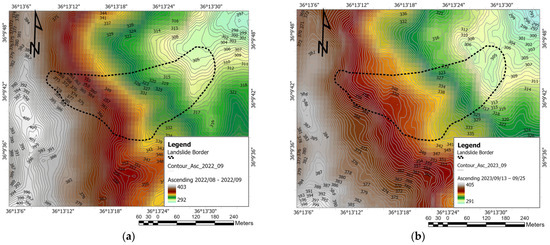
Figure 4.
Topography derived from the DEMs of the study area. (a) Pre-earthquake contours from Ascending 2022/08–2022/09. (b) Post-earthquake contours from Ascending 2023/09/13–09/25.
The Civil CAD 3D (2024) software and its tools allowed surface and volumetric comparisons across the various obtained contour levels. To select the most representative surfaces before and after the earthquake events, differences in surfaces from the DEMs were processed. This involved comparisons of different combinations of all the surfaces, including the most outdated surfaces before the earthquake, those times closely before and after, and all surfaces after the event. Different combinations of the comparisons are given in Table 4. Type A corresponds to the comparisons between surfaces before the earthquake, Type B compares surfaces before and after the earthquake, and Type C compares surfaces after the earthquake. The DEM values derived from both ascending and descending orbits captured vertical changes in DEMs up to 20 m at the crown and in some areas of the main body, as shown in Figure 5g,h.

Table 4.
Surfaces from DEM comparison combinations.
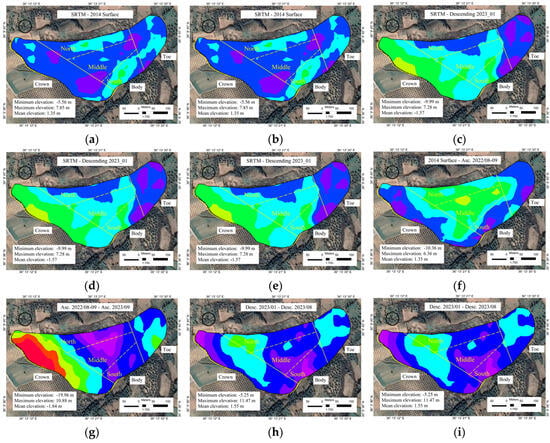

Figure 5.
Resulting change in surface for comparison between surfaces before, Type A: (a) Comparison A1, (b) Comparison A2, (c) Comparison A3, (d) Comparison A4, (e) Comparison A5, and (f) Comparison A6. Resulting change in surface for comparison between surfaces before and after, Type B: (g) Comparison B1, (h) Comparison B2, (i) Comparison B3, and (j) Comparison B4. Resulting change in surface for comparison between surfaces after, Type C: (k) Comparison C1. (l) Subdivided main landslide areas and color range used to summarize the change in surface.
The comparisons of the surfaces, which highlight the elevation change across various ranges, along with the minimum, maximum, and mean elevations for each comparison, are shown in Figure 5a–l. To further streamline the analysis, the areas affected by the landslide are considered as illustrated in Figure 5l. In this figure, the crown, toe, and body of the landslide are delineated, and the corresponding maximum and minimum changes for each combination within these areas are identified.
The resulting values are summarized in Table 5. The results represent the difference in elevation, where positive (+) values indicate higher elevations and negative (−) values indicate lower elevations when comparing each surface against the base surface defined in Table 3.

Table 5.
Simplified value changes in the compared surfaces at each landslide subdivided area.
Based on this comparison, it can be concluded that the DEM outputs were accurate in capturing elevation changes before and after the earthquake at specific locations along the landslide. This accuracy is attributed to terrain parameters such as aspect and slope angles, which are well-suited for the microwave reflections emitted by the SAR satellite (incidence and azimuth angles). Discrepancies observed in the Type A and Type C comparisons were lower than the 15 m DEM resolution, and the variations obtained were within expected ranges. Type B analysis allowed a clearer identification of which surfaces better captured the landslide movement. Slightly higher variations were observed when comparing ascending and descending orbits, which can be explained by differences in acquisition geometry and viewing angles between the two orbit directions. R-index models, as proposed by [33], assess the terrain visibility in SAR images. R-index models for the same ascending and descending orbits used in DEM generation are shown in Figure 6. Low-sensitivity regions, represented by values in the range of 0 to 0.5 and overlaid with warm colors, are prone to geometric distortions and noise [34], as shown in Figure 6a,c. The ascending orbit exhibited higher SAR image line of sight sensitivity, particularly at the landslide crown (Figure 1) and the middle and southern parts of the landslide body (Figure 6a,b). In contrast, the descending orbit showed lower R-index values, especially at the crown and portions of the middle and northern landslide body (Figure 6c,d). Due to the higher line of sight sensitivity at the landslide crown, the DEM generated from the S-1 ascending SAR orbit and its images was able to capture elevation changes more accurately than the S-1 descending orbit.
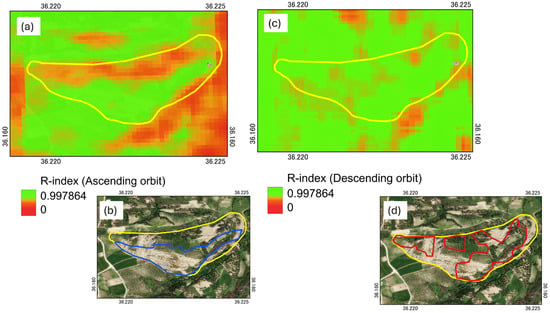
Figure 6.
R-index models for the ascending and descending Sentinel-1 SAR orbits (a,c). (b,d) are corresponding optical images; the landslide area is annotated by yellow polygons; high R-index values are annotated by blue and red polygons, respectively.
4.2. Defining the Critical Profile for the Static and Pseudo-Static Stability Analysis
For the static and pseudo-static stability analyses, a critical profile representing the slip surface after the earthquake is required. This profile must be obtained from a well-representative alignment across the landslide area. The definition of the alignment considers the non-straight behavior of the landslide by evaluating topographic variations such as changes in slope gradient and curvature. These variations influence slope stability and should be adequately captured in the selected alignment. The applied criterion corresponds to following steeper paths, aligning the critical profile to represent the total length of the landslide. The correction aims to connect the tip (farthest point from the highest point between the displaced material and the main scarp) to the crown [35]. Slope paths often represent the direction of potential failure planes more accurately, especially in slopes with variable geometry or geological features. Additionally, the alignment of failure planes perpendicular to contour levels helps ensure that the analysis accurately represents the geometry and respects the natural flow of water and geological structures. The alignment location over the aerial view of the site after the earthquake is shown in Figure 7a, while the slope map derived from the SRTM, which is the oldest available data representing the study area before any movements, is given in Figure 7b. The arrows on the map indicate the direction of the slope that was used to define the trend for the alignment represented by the red line (A-A section) as depicted in Figure 7c–e.
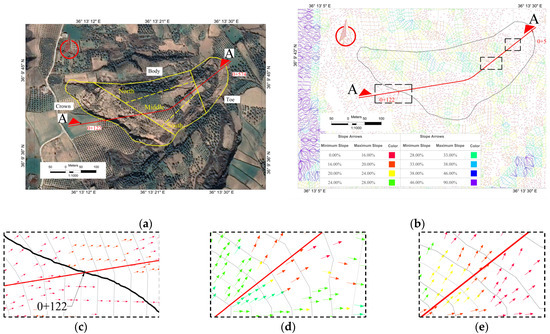
Figure 7.
(a) Aerial view and alignment definition. (b) Slope arrow map. (c–e) Close up of the alignment definition aligned to the slope direction.
The final profile for further analysis is shown in Figure 8. It represents the geomorphological behavior of the slope over different periods. Despite the expected 5-to-10 m differences in land topography due to the DEMs’ accuracy, the profiles can still demonstrate the slope’s behavior over time. Considering that SRTM represents the landscape as of the year 2000, a comparison with the 2022 profile (just before the event) cannot significantly prove the expected millimeter-scale downward movement. This is because the difference for this comparison ranges from 2 to 8 m (see A2 in Table 4). Although this does not prove the previous movement in the area, it allows us to define the 2022 profile as the pre-event profile. This is justified as the DEM variations from 2000 to 2020 do not exceed 8 m at the crown and are even up to 2 m at the body and toe. Once this profile has been defined, it is possible to project the stated stratigraphy following a tendency parallel to the ground, as reviewed from its geological formation. Furthermore, the profile representing 2023, after the earthquake, is particularly relevant as it captures deep variations in the slope due to the event. Additionally, it captures the bulge developed within the body of the landslide due to the movement of the block mass.
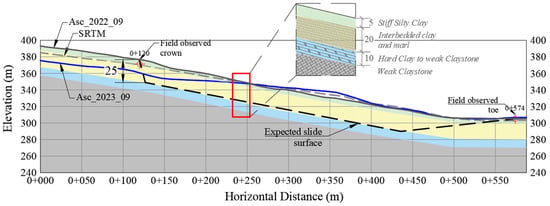
Figure 8.
Profile for the static and pseudo-static stability analyses.
Figure 8 also shows the estimated sliding surface, which has been defined to be at a depth of 25 m, rather than 20 m, to account for DEM variation and the previously analyzed descriptions of the site after the event. These records also help to delineate the crown and toe of the landslide, as it did not extend back to the top of the slope as the profile difference depicted.
5. Limit Equilibrium Analysis
The analysis was conducted using GeoStudio software version 23.1.2.11 employing SLOPE/W, a component of GeoStudio’s comprehensive set of geotechnical products [26]. The geometry is defined based on the previously established stratigraphy and the final profile shown in Figure 9. In addition, considering that the geotechnical team during the site recognition did not record the groundwater presence, the groundwater level is assumed to be below the extent of the landslide. The pseudo-static analysis incorporates the earthquake load by considering the defined horizontal seismic coefficients (kh).
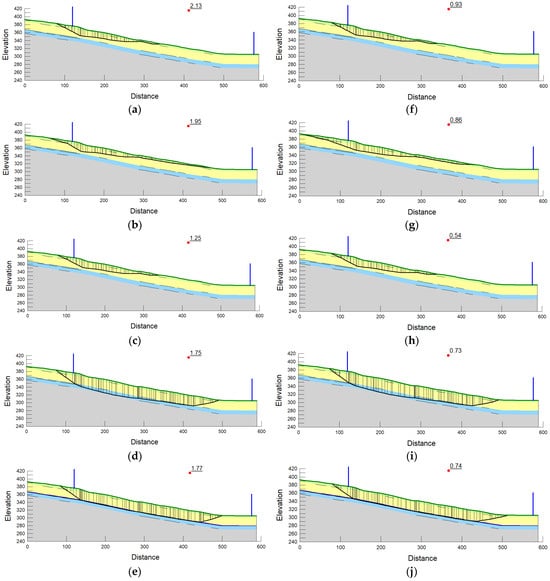
Figure 9.
Static stability analysis resulting in FoS and sliding surface: (a) Scenario 1, (b) Scenario 2, (c) Scenario 3, (d) Scenario 4, and (e) Scenario 5. Pseudo-static stability analysis of the FoS: (f) Scenario 1, (g) Scenario 2, (h) Scenario 3, (i) Scenario 4, and (j) Scenario 5.
The geotechnical parameters used in the analysis were primarily based on [5], who characterized the upper layer after the earthquake and reported it to consist of 66.6% of clay, 28% of lime, and 5.8% of sand. When the specific features of the site geology are considered, such as the low friction angles and clay fraction, it is plausible to infer that the layers exhibit a medium to high plasticity range of approximately 50% to 90%. To complement this, residual friction angles were estimated using the relationship proposed by [29], which links the friction angle with the plasticity index and clay composition.
The starting point for defining the strength parameters for the back-analysis was based on the geological site conditions. Hence, different scenarios were defined to account for stiff conditions on a drained parameters basis. It is important to understand that delayed first-time slope failures can occur due to time-dependent mechanisms such as swelling, softening, and creep. Fully softened conditions may develop on parts of the slip surface that intersect the bedding planes and laminations in stiff fissured clays and shales. Furthermore, these bedding planes and laminations, acting as stratigraphic discontinuities in the stiff clays and clay shales, can affect the mobilized shear strength by creating pathways for localized shearing strain, promoting residual conditions, and weakening the slope materials overall [36].
In the analyses, five scenarios are proposed, considering the complex interbedded stratigraphy and the potential for slope creep to cause delayed first-time slope failure. These scenarios account for the possibility of a first-time landslide or a reactivated landslide, where the strata conditions can range from fully softened to residual. The strength parameters were adjusted for each scenario to capture these variations; the given values are listed in Table 6.

Table 6.
Parameters assigned for different scenarios.
In the limit equilibrium analysis, lock-specified slip surfaces with activated optimization were considered to determine the most critical slip surface shapes and positions. This involves searching for non-circular surfaces to better represent potential failure mechanisms. The critical slip surfaces identified in this step were then used in the pseudo-static analysis to assess stability under seismic conditions. The geometry of the blocks is set up, defining their shape, dimensions, and orientation relative to the slope at the crown and toe of the landslide. All analyses considered a minimum slip surface depth of 20 m to capture deeper potential failure. Finally, traditional back-analysis of the entire slide mass was performed on the scenarios that most closely represent the expected slip surface.
After defining the sliding plane under static conditions with the assigned strength parameters, the seismic coefficient was applied to the slip surface to evaluate the pseudo-static condition of the landslide. The FoS for each scenario was computed for both analyses. Figure 9 presents the critical slide surface and the respective FoS values for each scenario and analysis. Based on field observations, the limits of the crown and toe, indicated by blue lines, were defined. As can be seen in Figure 9a–c, neither the first scenario, which considers a first-time landslide with all layers in a fully softened condition, nor the reactivated landslide scenarios with the upper layers in residual conditions (Scenarios 2 and 3) fully simulate the translational developed landslide. They maintain their critical slip surface in the upper zone of the slope around the crown, at a maximum depth of 20 m. Meanwhile, Figure 9d,e, Scenarios 4 and 5, which consider a delayed first-time landslide with a subsurface residual layer, develop a critical slip surface extending to a maximum depth of 35 m and 27 m, respectively, covering almost the entire slope from the crown and closer to the toe.
The FoS values obtained for each scenario, along with the maximum depth of the slip surface, are summarized in Table 7. According to the results, the slip surfaces in Scenarios 4 and 5 closely match the estimations based on topography. Notably, the FoS values under pseudo-static conditions for both scenarios are below unity, as shown in Figure 9i,j. Therefore, considering the defined stratigraphy behavior for a delayed first-time landslide, a back-analysis was performed to adjust the mobilized residual strength of the subsurface layer.

Table 7.
Summary of FoS for the static and pseudo-static analysis for each scenario.
The estimated slip surface and its location within the defined stratigraphy used in the analysis for Scenarios 4 and 5 are shown in Figure 10a,b, respectively. Additionally, the slip surface with the corresponding FoS value of 1.0 is given in Figure 10c,d once the residual strength has been adjusted. The final parameters defined for each layer are summarized in Table 8, where the hard clay to weak claystone is back-calculated to a friction angle of 21°.
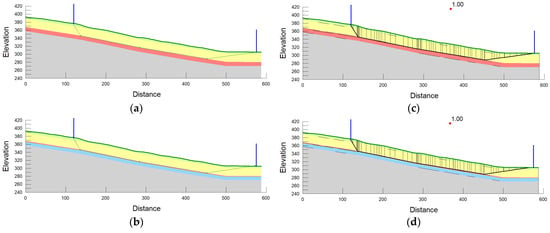
Figure 10.
Estimated slide surface definition for (a) Scenario 4 and (b) Scenario 5. Back-analysis resulting in a FoS = 1.0 for (c) Scenario 4 and (d) Scenario 5.

Table 8.
Back-calculated parameters for Scenarios 4 and 5.
6. Conclusions
This study focused on the time evolution and back-analysis of the Tepehan landslide using remotely sensed data. First, geomorphological changes were assessed to calibrate the surface conditions before and after the earthquake. Shear strength parameters were estimated from the well-established correlations for further analysis of the limit equilibrium. The main conclusions drawn from this study are as follows:
- Topographic variations in the landslide area were analyzed using digital elevation models (DEMs) derived from ascending and descending orbits of Sentinel-1 SAR data. SAR images from the ascending orbit showed a high R-index (line of sight sensitivity), particularly at the landslide crown. Thus, the DEM generated from the ascending orbit SAR data captured the elevation change more accurately, compared to the SAR images of the Sentinel-1 descending orbit track.
- Overall, the soil stratigraphy is well-founded, based on geological history and existing site descriptions, allowing for a reasonable slope profile simulation. Discrepancies between the assumed soil layers and the detailed site investigations can be addressed by sample testing and comparison with assumed parameters.
- The depth of the slip surface reaches from 27 m to 35 m depending on the thickness of the residual bedding layer, from a thin layer in Scenario 5 to a 10 m layer in Scenario 4, respectively. Although the depth variation is significant, it is not a fixed measure. Nevertheless, both scenarios showed very close values of the FoS in static and pseudo-static conditions. Consequently, variations in the slip surface depth within the 20 m to 30 m range, as found in the literature, will not significantly impact the limit equilibrium analyses.
- The analyzed scenarios indicate that the slope behaves as a delayed first-time landslide. The bedding plane in the hard clay acts as a stratigraphic discontinuity, reducing the mobilized shear strength and creating paths for localized shearing strain. This leads to residual conditions and an overall weakening of the slope materials.
- Although the strength parameters were defined using a limit equilibrium pseudo-static approach, the soil stratigraphy and fully softened friction angles, along with the adjusted friction angle for the hard clay layer from 16° to 21°, remain applicable for future investigations of site behavior. Additionally, these parameters can be further refined through more detailed numerical approaches.
The results and conclusions specifically account for the effects of earthquake loading at the Tepehan landslide. More detailed conclusions on additional triggering effects could be drawn with additional data obtained from further site investigation.
Author Contributions
Conceptualization, T.B.; methodology, T.B.; investigation, K.N., N.I.M., and A.Y.; resources, A.Y., V.S., and T.B.; writing—original draft, N.I.M., K.N., A.Y., T.B., and V.S.; writing—review and editing, K.N., T.B., A.Y., and V.S. All authors have read and agreed to the published version of the manuscript.
Funding
This research received no external funding.
Data Availability Statement
The raw data supporting the conclusions of this article will be made available by the authors on request.
Acknowledgments
This study was made possible by the discretionary funds provided by the Department of Civil and Environmental Engineering at University of Illinois Urbana-Champaign. The authors acknowledge the contributions from Ozgun Alp Numanoglu and Serhat Erinmez for assisting with the data collection during the field campaign and Thierno Kane for his invaluable insights and guidance on the slope stability analyses.
Conflicts of Interest
The authors declare no conflict of interest.
References
- Karslı, H.; Babacan, A.E.; Akın, Ö. Subsurface characterization by active and passive source geophysical methods after the 06 February 2023earthquakes in Turkey. Nat. Hazards 2024, 120, 5257–5286. [Google Scholar] [CrossRef]
- Yan, K.; Miyajima, M.; Kumsar, H.; Aydan, Ö.; Ulusay, R.; Tao, Z.; Chen, Y.; Wang, F. Preliminary report of field reconnaissance on the 6 February 2023 Kahramanmaras Earthquakes in Türkiye. Geoenviron. Disasters 2024, 11, 1–24. [Google Scholar] [CrossRef]
- Görüm, T.; Tanyas, H.; Karabacak, F.; Yılmaz, A.; Girgin, S.; Allstadt, K.E.; Süzen, M.L.; Burgi, P. Preliminary documentation of coseismic ground failure triggered by the February 6, 2023 Türkiye earthquake sequence. Eng. Geol. 2023, 327, 107315. [Google Scholar] [CrossRef]
- GEER Association. Türkiye Earthquakes: Report on Geoscience and Engineering Impacts. Earthquake Engineering Research Institute, LFE Program GEER Association Report; GEER Association: Kansas City, MO, USA, 2023. [Google Scholar] [CrossRef]
- Dölek, İ.; Uzelli, T.; Ege, İ.; Çelik, Ö. An example of mass movements caused by the Kahramanmaraş earthquakes of february 6: Tepehan landslide. Türk Coğrafya Dergisi 2023, 83, 73–86. [Google Scholar] [CrossRef]
- Milev, N.; Tobita, T.; Kiyota, T.; Shiga, M. Rapid detection of landslides mechanisms and assessment of their geometry and dimensions by means of a drone survey (UAV) after the 2023 Turkey-Syria earthquake. National Transport Infrastructure Conference with International Participation. IOP Conf. Ser. Mater. Sci. Eng. 2023, 1297, 012009. [Google Scholar] [CrossRef]
- Medhat, N.I.; Nieto, K.; Numanoglu, O.A.; Baser, T. Revealing failure mechanisms of the Tepehan landslide using satellite-borne InSAR data. In Proceedings of the 18th World Conference on Earthquake Engineering (WCEE2024), Milan, Italy, 30 June–5 July 2024. [Google Scholar]
- Tarı, U.; Tüysüz, O.; Genç, Ş.C.; İmren, C.; Blackwell, B.A.; Lom, N.; Tekeşin, Ö.; Üsküplü, S.; Erel, L.; Altıok, S.; et al. The geology and morphology of the Antakya Graben between the Amik Triple Junction and the Cyprus Arc. Geodin. Acta 2014, 26, 27–55. [Google Scholar] [CrossRef]
- Kavuzlu, M. Tectono-Stratigraphy of Altınözü (Antakya) and Its Vicinity. Master’s Thesis, Department of Geological Engineering, Institute of Natural and Applied Sciences, Çukurova University, Çukurova, Turkey, 2006. [Google Scholar]
- The Disaster and Emergency Management Authority (AFAD) of Turkey. Compilation of Data Base for The National Strong-Motion Seismograph Network in Turkey: Report on Seismic and Geotechnical Investigations; The Disaster and Emergency Management Authority (AFAD) of Turkey: Ankara, Turkey, 2006; Seismograph Station AI_029_MAT02. [Google Scholar]
- Bray, J.D.; Travasarou, T. Pseudostatic Coefficient for Use in Simplified Seismic Slope Stability Evaluation. J. Geotech. Geoenviron. Eng. 2009, 135, 1336–1340. [Google Scholar] [CrossRef]
- Baker, R.; Shukha, R.; Operstein, V.; Frydman, S. Stability charts for pseudo-static slope stability analysis. Soil Dyn. Earthq. Eng. 2006, 26, 813–823. [Google Scholar] [CrossRef]
- Seed, H.B. Considerations in the earthquake-resistant design of earth and rockfill dams. Geotechnique 1979, 29, 215–263. [Google Scholar] [CrossRef]
- Marcuson, W.F., III; Franklin, A.G. Seismic Design Analysis Remedial Measures to Improve Stability of Existing Earth Dams (Final Report); Geotechnical Laboratory, U.S. Army Engineer Waterways Experiment Station: Vicksburg, MI, USA, 1983. [Google Scholar]
- Hynes-Griffin, M.E.; Franklin, A.G. Rationalizing the Seismic Coefficient Method; Geotechnical Laboratory, Department of the Army, Waterways Experiment Station, Corps of Engineers: Vicksburg, MI, USA, 1984; Prepared for Department of the Army, US Army Corps of Engineers, Washington, DC.1984. [Google Scholar]
- Melo, C.; Sharma, S. Seismic Coefficients for Pseudostatic Slope Analysis (Paper No. 369). In Proceedings of the 13th World Conference on Earthquake Engineering, Vancouver, BC, Canada, 1–6 August 2004. [Google Scholar]
- Pyke, R. Selection of Seismic Coefficients for Use in Pseudo-Static Slope Stability Analyses; California Division of Mines and Geology: Sacramento, CA, USA, 1991.
- Xiong, L.; Li, S.; Tang, G.; Strobl, J. Geomorphometry and terrain analysis: Data, methods, platforms and applications. Earth-Sci. Rev. 2022, 233, 104191. [Google Scholar] [CrossRef]
- ESRI. Surface Creation Analysis, ArcGIS. 2016. Available online: https://desktop.arcgis.com/en/arcmap/10.3/analyze/commonly-used-tools/surface-creation-and-analysis.htm (accessed on 20 January 2024).
- Zhang, Y.; Meng, X.; Jordan, C.; Novellino, A.; Dijkstra, T.; Chen, G. Investigating slow-moving landslides in the Zhouqu region of China using InSAR time series. Landslides 2018, 15, 1299–1315. [Google Scholar] [CrossRef]
- Mohammed, O.I.; Saeidi, V.; Pradhan, B.; Yusuf, Y.A. Advanced differential interferometry synthetic aperture radar techniques for deformation monitoring: A review on sensors and recent research development. Geocarto Int. 2014, 29, 536–553. [Google Scholar] [CrossRef]
- SARscape. SARscape tutorials–Interferometry, Digital elevation model creation. I NV5 Geospatial. 2023. Available online: https://www.sarmap.ch/index.php/software/sarscape/ (accessed on 1 November 2024).
- Hussain, M.; Stark, T.D.; Akhtar, K. Back-Analysis Procedure for Landslides. In Proceedings of the International Conference on Geotechnical Engineering, Lahore, Pakistan, 5–6 November 2010. [Google Scholar]
- Huang, Y.H. Slope Stability Analysis by the Limit Equilibrium Method: Fundamentals and Methods; ASCE Press: Reston, VA, USA, 2014; pp. 1–376. ISBN 978-0784412886. [Google Scholar]
- Gilbert, R.B.; Wright, S.G.; Liedtke, E. Uncertainty in Back Analysis of Slopes: Kettleman Hills Case History. J. Geotech. Geoenviron. Eng. 1998, 124, 1167–1176. [Google Scholar] [CrossRef]
- GEO-SLOPE International Ltd. Stability Modeling with Geostudio (2004–2021); GEO-SLOPE International Ltd.: Calgary, AB, Canada, 2022. [Google Scholar]
- Towhata, I. Geotechnical Earthquake Engineering; Springer: Berlin, Germany, 2008. [Google Scholar] [CrossRef]
- Koo, R.C.H.; Kong, V.; Tsang, H.H.; Pappin, J.W. Seismic slope stability assessment in a moderate seismicity region, Hong Kong. In Proceedings of the 14th World Conference on Earthquake Engineering, Beijing, China, 12–17 October 2008. [Google Scholar]
- Terzaghi, K.; Peck, R.B.; Mesri, G. Soil Mechanics in Engineering Practice, 3rd ed.; John Wiley and Sons, Inc.: New York, NY, USA, 1996. [Google Scholar]
- Mesri, G.; Shahien, M. Residual Shear Strength Mobilized in First-Time Slope Failures. J. Geotech. Geoenviron. Eng. 2003, 129, 12–31. [Google Scholar] [CrossRef]
- Glade, T.; Crozier, M.; Smith, P. Applying Probability Determination to Refine Landslide-triggering Rainfall Thresholds Using an Empirical “Antecedent Daily Rainfall Model”. Pure Appl. Geophys. 2000, 157, 1059–1079. [Google Scholar] [CrossRef]
- Pike, R.J.; Evans, I.S.; Hengl, T. Geomorphometry: A Brief Guide. In Developments in Soil Science; Elsevier: Amsterdam, The Netherlands, 2009; Volume 33, ISSN 0166-2481. [Google Scholar] [CrossRef]
- Notti, D.; Herrera, G.; Bianchini, S.; Meisina, C.; García-Davalillo, J.C.; Zucca, F. A methodology for improving landslide PSI data analysis. Int. J. Remote. Sens. 2014, 35, 2186–2214. [Google Scholar] [CrossRef]
- Guo, R.; Li, S.; Chen, Y.; Li, X.; Yuan, L. Identification and monitoring landslides in Longitudinal Range-Gorge Region with InSAR fusion integrated visibility analysis. Landslides 2021, 18, 551–568. [Google Scholar] [CrossRef]
- Abramson, L.W.; Lee, T.S.; Rathbun, S.D. Slope Stability and Stabilization Methods; John Wiley & Sons: Hoboken, NJ, USA, 2002. [Google Scholar]
- Skempton, A.W.; Petley, D.J. The strength along structural discontinuities in stiff clays. In Proceedings of the Geotechnical Conference, Oslo, Norway, 1967; Volume 2, pp. 29–46. [Google Scholar]
Disclaimer/Publisher’s Note: The statements, opinions and data contained in all publications are solely those of the individual author(s) and contributor(s) and not of MDPI and/or the editor(s). MDPI and/or the editor(s) disclaim responsibility for any injury to people or property resulting from any ideas, methods, instructions or products referred to in the content. |
© 2025 by the authors. Licensee MDPI, Basel, Switzerland. This article is an open access article distributed under the terms and conditions of the Creative Commons Attribution (CC BY) license (https://creativecommons.org/licenses/by/4.0/).




